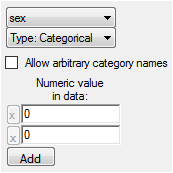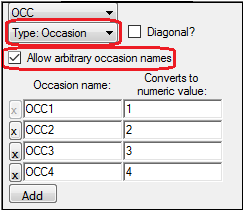The Covariate Type tab allows users to specify covariate types. The default setting for each covariate is Continuous.

-
In the top, unlabeled menu, select the covariate.
-
In the Type menu, select the covariate type: Continuous, Categorical, Occasion.
If Categorical is selected, users can enter values for the categories. A minimum of two categories is required for categorical covariates.

•In the Numeric value in data field, type a value for each category. It is typically best to use consecutive integers, starting at zero.
•If the Allow arbitrary category names checkbox is checked, the user is able to specify a name for each category and enter an associated value. The categorical values entered must be in the main input dataset.
Note that the actual text values that were in the dataset will appear in the Settings output and History to clarify the mappings that were set (e.g., covr(Gender<-”TextGender”(Male=0, Female=2))).
•To add another category, click Add.
•To remove a category, click the corresponding X button.
If Occasion is selected, users can enter values for the dosing or observation occasions. A minimum of two categories is required for interoccasional covariates (refer to “Setting up interoccasional covariates”).

•In the Numeric value in data field, type a value for each occasion.
•Check the Allow arbitrary occasion names checkbox to specify a name for each category and enter an associated value. The occasion values entered must be in the main input dataset.
•To add another dosing or observation occasion, click Add.
•To remove a dosing or observation occasion, click the X button.
•Use the Diagonal? checkbox to set the interoccasion covariance to a diagonal structure (box is checked, this is the default) or block structure (box is unchecked).
![]() Occasion covariates are always available but they are only used with population models. They are not used with the individual models that Phoenix processes. Using occasion covariates with individual models has no effect on the model or the output.
Occasion covariates are always available but they are only used with population models. They are not used with the individual models that Phoenix processes. Using occasion covariates with individual models has no effect on the model or the output.
Setting up interoccasional covariates
If there is to be interoccasion variability (IOV) in a population model, there are several steps to follow.
-
In the Parameters/Structural tab add a covariate and specify the variables it is to effect.

-
Then, on the Covar. Type tab, set the type of the covariate to Occasion.

Note that, if Allow arbitrary occasion names is checked, two columns are presented in which arbitrary occasion names (including non-numeric) can be entered in the left column and corresponding numeric values on the right.
The checkbox labeled Diagonal is discussed a little later.
-
Select the Random Effects tab.

In the upper box are simple random effects, one for each structural parameter that has randomness. The reason there is no checkbox under Same is because there is only one block, and that option only appears between blocks and only if they are the same shape. If Same is checked, it means that the lower block shares the same matrix as the upper block. In this case, the lower block is not displayed because its numbers cannot be edited.
The lower box has the first block of random effects for the occasion covariate effect. There are actually four blocks, one for each value of the occasion covariate, but only the first is shown, because the other three are all the same as the first. Note that there is no button for Break, and no checkbox for Same. That is because the IOV random effect structure is entirely specified by the choices made on the previous tabs, so they cannot be changed here. Also note that, in this case, the omega matrix for these three random effects is a lower-triangle block, not diagonal. It can be made diagonal by checking the Diagonal checkbox previously mentioned on the Covar. Type tab.
It is helpful to see what this does in the generated model text.
-
OCC is declared to be a covariate:
covariate(OCC)
-
The random effects are declared using the “same” notation:
ranef(block(nE0x0,nEC50x0,nEmaxx0)=c(0.1,0,1,0,0,1)
, same(nE0x1,nEC50x1,nEmaxx1)
, same(nE0x2,nEC50x2,nEmaxx2)
, same(nE0x3,nEC50x3,nEmaxx3)
)
Note that there are four sets of three random effects each. The omega matrix for the first set is shared by the following three.
-
The way these random effects appear in the model is that the value of the OCC covariate selects which random effect is active at any one time, like this:
stparm(EC50=tvEC50*exp(nEC50
+ nEC50x0*(OCC == 1)
+ nEC50x1*(OCC == 2)
+ nEC50x2*(OCC == 3)
+ nEC50x3*(OCC == 4)
))
(There are further statements for each of the structural parameters to be effected.) This differs from a typical categorical covariate effect in which the covariate selects a fixed effect, as opposed to a random effect.
